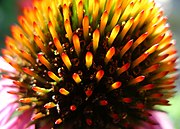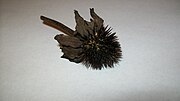
Echinacea is a genus of herbaceous flowering plants in the daisy family. It has ten species, which are commonly called coneflowers. They are found only in eastern and central North America, where they grow in moist to dry prairies and open wooded areas. They have large, showy heads of composite flowers, blooming in summer. The generic name is derived from the Greek word ἐχῖνος, meaning "hedgehog", due to the spiny central disk. These flowering plants and their parts have different uses. Some species are cultivated in gardens for their showy flowers. Two of the species, E. tennesseensis and E. laevigata, were formerly listed in the United States as endangered species; E. tennesseensis has been delisted due to recovery and E. laevigata is now listed as threatened.

Rudbeckia hirta, commonly called black-eyed Susan, is a North American flowering plant in the family Asteraceae, native to Eastern and Central North America and naturalized in the Western part of the continent as well as in China. It has now been found in all 10 Canadian Provinces and all 48 of the states in the contiguous United States.

Echinacea angustifolia, the narrow-leaved purple coneflower or blacksamson echinacea, is a species of flowering plant in the family Asteraceae. It is native to North America, where it is widespread across much of the Great Plains of central Canada and the central United States, with additional populations in surrounding regions.

Rudbeckia is a plant genus in the Asteraceae or composite family. Rudbeckia flowers feature a prominent, raised central disc in black, brown shades of green, and in-between tones, giving rise to their familiar common names of coneflowers and black-eyed-susans. All are native to North America, and many species are cultivated in gardens for their showy yellow or gold flower heads that bloom in mid to late summer.

Rudbeckia laciniata, the cutleaf coneflower, is a species of flowering plant in the family Asteraceae. It is native to North America, where it is widespread in both Canada and the United States. Its natural habitat is wet sites in flood plains, along stream banks, and in moist forests. Common names other than cutleaf coneflower include cutleaf, goldenglow, green-headed coneflower, tall coneflower, sochan and thimbleweed.
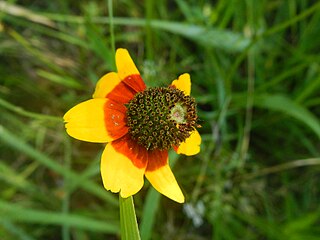
Dracopis is a monotypic genus with Dracopis amplexicaulis the sole species. It is native to North America.

Echinacea tennesseensis, also known as the Tennessee coneflower or Tennessee purple coneflower, is a flowering plant in the family Asteraceae, endemic to the cedar glades of the central portion of the U.S. state of Tennessee.

Rudbeckia fulgida, the orange coneflower or perennial coneflower, is a species of flowering plant in the family Asteraceae, native to eastern North America.

Rudbeckia triloba, the browneyed or brown-eyed susan, thin-leaved coneflower or three-leaved coneflower, is a species of flowering plant in the family Asteraceae with numerous, yellow, daisy-like flowers. It is native to the central and eastern United States and is often seen in old fields or along roads. It is also cultivated as an ornamental.
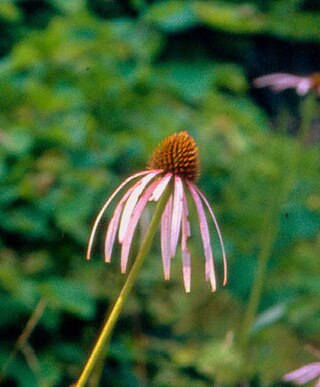
Echinacea laevigata, the smooth purple coneflower, is a federally listed threatened species of plant found in the Piedmont of the eastern United States. Most populations are found on roadsides and other open areas with plenty of sunlight, often on calcium- and magnesium- rich soils.

Ipomoea indica is a species of flowering plant in the family Convolvulaceae, known by several common names, including blue morning glory, oceanblue morning glory, koali awa, and blue dawn flower. It bears heart-shaped or three-lobed leaves and purple or blue funnel-shaped flowers 6–8 cm (2–3 in) in diameter, from spring to autumn. The flowers produced by the plant are hermaphroditic. This plant has gained the Royal Horticultural Society's Award of Garden Merit.

Echinacea atrorubens, called the Topeka purple coneflower, is a North American species of flowering plant in the family Asteraceae. It is native to eastern Kansas, Oklahoma, and eastern Texas in the south-central United States. It is found growing in dry soils around limestone or sandstone outcroppings and prairies.
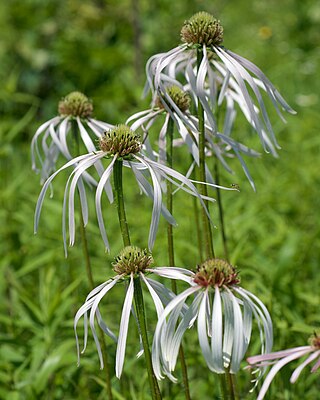
Echinacea pallida, the pale purple coneflower, is a species of herbaceous perennial plant in the family Asteraceae. It is sometimes grown in gardens and used for medicinal purposes. Its native range is the central region of the United States and Ontario, Canada.

Echinacea simulata, commonly called wavy leaf purple coneflower, glade coneflower, or prairie purple coneflower, is a species of perennial flowering plant in the family Asteraceae. It is native to the east-central states of the United States. Its natural habitat is dry, calcareous, open areas such as barrens and woodlands.
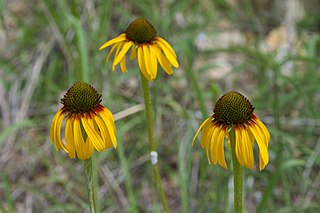
Echinacea paradoxa, the yellow coneflower, Bush's purple coneflower, or Ozark coneflower, is a North American species of flowering plant in the family Asteraceae. It is native to southern Missouri, Arkansas, and south-central Oklahoma, It is listed as threatened in Arkansas.

Symphyotrichum lateriflorum is a species of flowering plant in the aster family (Asteraceae). Commonly known as calico aster, starved aster, and white woodland aster, it is native to eastern and central North America. It is a perennial and herbaceous plant that may reach heights up to 120 centimeters and widths up to 30 centimeters.

Zinnia elegans known as youth-and-age, common zinnia or elegant zinnia, is an annual flowering plant in the family Asteraceae. It is native to Mexico but grown as an ornamental in many places and naturalised in several places, including scattered locations in South and Central America, the West Indies, the United States, Australia, and Italy.
Echinacea serotina, the narrow-leaved purple coneflower or blacksamson echinacea, is a species of flowering plant in the family Asteraceae. It is native to the states of Arkansas and Louisiana in the United States. The species is sometimes listed as being found only in Louisiana, but the type collection was made in Arkansas, part of Louisiana at the time.
Eastern coneflower is a common name for several plants and may refer to:

Rudbeckia texana, commonly known at Texas coneflower or shiny coneflower, is a perennial plant in the family Asteraceae native to the Western Gulf coastal grasslands of Texas and Louisiana.


